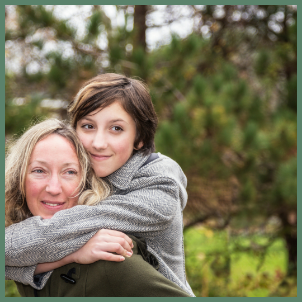DEVELOPING STRESS AND TRAUMA
As a parent of a child with something “wrong” you become more vulnerable. What you knew as reality has changed… it had to because nothing stayed the same. Your legs were knocked out from under you. Life goes on, but sometimes you can’t find any firm ground to stand on, set adrift in an ocean of uncertainty and fear.
Your inner personal strength kicks in as you look for things you know and understand to anchor yourself to, but that doesn’t always work. You try to keep your head above water in this new reality, trying to keep your wits about you because you know if you kick and thrash too much, you just might sink and go under.
Eventually, you find your footing in this new reality. It’s not the same, it’s not bad, it’s just different. You took a hit, an ocean of stress and trauma that elevated your cortisol levels. You still get that feeling, maybe at one of your child’s meetings or when there is a new developmental milestone with challenges to face. But you are ready to consider what you can do to increase your resilience, happiness and well-being. See where you fall on the happiness continuum and take this free quiz to find out!

Optimism and Happiness is Teachable, Obtainable and Builds Resilience
DESTINATION: TRAUMA
My child’s challenges started to build over time. Looking back, I know I was headstrong, thinking I’m going to give this all I’ve got. My mother had mental health issues, and growing up with that in my life was tough. If I can overcome that I thought, I can do anything. I’m going to beat whatever this is that is going on for my child. Even if it means self-sacrificing my own self-care, and possibly other family members as well, after all, they’re ok, right?
I was driving my son to his 2nd therapy session of the day. It had been a sleepless night as I tirelessly tried to coax him into sleeping in his own room instead of coming down the hall and disturbing my much-needed sleep. The relentless exhaustion had reached its breaking point that morning, causing me to experience a strange floating sensation. I thought to myself, “I should not be driving a car- I’m too tired.” At that point, I realized something had to change.
“Trauma can stem from a stressful experience or a bunch of recurring events that create a sense of overwhelming distress.”
So is this when the trauma started? Or was it when I received the diagnosis? Or was it later? What may be traumatic for me might not have the same impact on another, as individual reactions to events can vary based on personal history, resilience, and other factors. Just like a soldier that goes off to war, a person who experiences violence or abuse, or any one from a long list of traumatic experiences that a person can have, a variety of events or a combination of things could be the root cause. Trauma can stem from a stressful experience or a bunch of recurring events that create a sense of overwhelming distress. It can gradually manifest over weeks, months, or even years as individuals struggle to deal with their immediate circumstances, ultimately causing severe and long-lasting feelings of distress and trauma.
As I came to terms with what I could handle in my day to day life, I decided to let go of some of my typical standards to try and get more control in my life. I let my 3 year old son sleep in my bed, so that we all could get some sleep. Leaving the TV on while my son was eating, if it meant he would eat, and controlling the environment he would be in, if it meant we could leave the house. Getting through the day was the goal. Meeting everyone’s basic needs, not worrying about my own. It was enough for me to know we made it through the day, riding the ocean waves to get through life. No time or patience to try and improve my situation. It just was not feasible.
STAYING AFLOAT IN AN OCEAN OF TRAUMA
Learned helplessness refers to a state of passive resignation or lack of response to negative and uncontrollable situations. It occurs when individuals learn to believe that their actions have no effect on the outcomes they experience. As a result, they may become passive, exhibit reduced motivation, and fail to take actions that could potentially improve their situation.
Trauma can contribute to the development of learned helplessness. When individuals experience a traumatic event, it can shatter their sense of control and agency over their lives. The overwhelming nature of trauma can lead to a sense of powerlessness and a belief that they have no influence in shaping their circumstances. This loss of control can reinforce the learned helplessness mindset.

Long-term learned helplessness can contribute to the development of mental health issues and hinder personal growth, as individuals may feel unable to change their circumstances and may stop trying altogether.
However, it’s important to know that learned helplessness is not necessarily a permanent state. If you are starting to feel this way, try shifting your perspective, check your mindset and taking care of yourself. This can help build your resilience to help you regain a sense of control and agency in your life.
BE THE LIGHT HOUSE
I wish I would have known about learned optimism sooner. Moving from learned helplessness to learned optimism is a powerful journey towards mental resilience and a more positive outlook on life. The way I saw it was if I’m going to live through a difficult time, I can suffer through it or I can choose to move through it with some level of grace and ease. You choose. I chose to move toward happiness. I knew I deserved to live a happier life, and so did my family.
Learned optimism is a concept developed by psychologist Martin Seligman, which suggests that individuals can learn to have a more positive outlook on life by challenging negative thoughts and reframing their experiences. It involves developing a belief in one’s ability to overcome challenging situations and viewing setbacks as temporary and specific, rather than permanent and unchangeable.
Here are some tips to take the next steps:
1. Cultivate self-awareness: Developing self-awareness is crucial for understanding one’s thoughts, emotions, and behaviors. At the end of the day, or after a negative event, take time to reflect on your automatic negative thoughts and their impact on your mindset by considering how else the event could be looked at or considered. This inside look allows you to challenge and reframe negative beliefs.
2. Recognize learned helplessness: The first step is to become aware of learned helplessness, which is a belief that one has no control over their circumstances. It often develops after repeated experiences of what feels like a failure or a lack of control. So look for situations where you may shut down or don’t know how to deal with things in the moment because nothing has worked before. By acknowledging this mindset, individuals can start working towards change. This can be an opportunity to talk to your support time or another parent that is dealing with the same situation.

3. Challenge negative beliefs: Once you have some understanding of optimistic thinking, try to challenge negative beliefs and replace them with more optimistic thoughts. Look for evidence that goes against your learned helplessness, and remind yourself of past successes and personal strengths. By consciously choosing positive perspectives, you can gradually rewire your thinking.
4. Set realistic goals: Break down larger goals into smaller, achievable steps. This approach fosters a sense of control and helps you build confidence. Each small achievement acts as a stepping stone toward learned optimism.
5. Practice positive self-talk: Pay attention to your internal dialogue and actively replace self-defeating statements with positive affirmations. Encourage yourself and focus on your capabilities rather than dwelling on your limitations. Over time, this boosts self-confidence and a more optimistic mindset.

Shine your light on what you want to see in your world.
6. Surround yourself with positive influences: Surrounding yourself with supportive, optimistic individuals who believe in personal growth can have a profound impact on your own mindset. Seek out positive role models, mentors, or supportive friends to inspire and motivate you along the way.
7. Practice gratitude and mindfulness: Gratitude and mindfulness exercises can help shift your focus towards the present moment and cultivate a positive mindset. Take time each day to reflect on things you are grateful for, and practice mindfulness techniques such as deep breathing or meditation to reduce stress and increase resilience.
8. Embrace failure as a learning opportunity: Learn to view failures as stepping stones to growth rather than as permanent setbacks. Take on a growth mindset that sees mistakes as opportunities for improvement and learning. With each setback, ask yourself what you can learn and how you can change for future success.
Just know, transforming learned optimism from learned helplessness is a gradual process that requires patience and consistency. If you aren’t sure how or when to add this to your life, try and integrate learned optimism when an opportunity presents itself. For example, your car has a flat tire. You could look at it as a negative experience, that things like this always happen to you, or you could look at it more optimistically, and think that this kind of thing happens to everyone, and fortunately, not very often. Be gentle with yourself and celebrate every step forward, regardless of how small it may seem. With time and practice, you can develop a more optimistic outlook and reclaim a sense of control over your life.

CALMER WATERS CAN LEAD TO POST TRAUMATIC GROWTH
Post-traumatic growth (PTG) refers to the positive psychological changes some individuals experience after going through a traumatic event. It signifies personal growth, resilience, and a greater sense of meaning and purpose in life.

One of the factors that can contribute to post-traumatic growth is learned optimism. With an optimistic mindset, you are more likely to see challenges as temporary and solvable, which can lead to a greater sense of hope and resilience. The connection between learned optimism and post-traumatic growth lies in the way individuals perceive and interpret their traumatic experiences. When faced with a traumatic event, try to have an optimistic mindset. This can make you better equipped to find some positive meaning or opportunities for growth within difficult circumstances.
I had never heard of Post Traumatic Growth before. I was reading about Post Traumatic Stress Disorder (PTSD) and then found PTG in Positive Psychology. It was a revelation for me to know that it was possible to move past my trauma, and to begin to build a better, more meaningful life. As if I was given permission to do so. Start now. What do you have to lose?
Check out the Grow Your Happy Continnuum that ranges from unhappy: in crisis, struggling, surviving, with neutral in the middle. The happy side: hopeful, empowerd, thriving! Find out where you fall on the happiness continuum with our Quiz or join the membership, there’s one month free!!



